I stumbled onto Meganisi by pure accident during a sailing trip out of Lefkada. Honestly, it made me wonder why I kept going back to Greece’s crowded hotspots for so long.
This tiny Ionian island sits just 25 minutes by boat from Lefkada’s Nydri port. Somehow, it crams Norwegian-style fjords, hidden sea caves, and three real-deal villages into a place where locals still outnumber tourists.
Meganisi shows off Greece’s most dramatic fjord-like coastline outside of Norway. There’s the famous Papanikolis submarine cave and over 30 kilometers of intricate bays carved into just 22 square kilometers of island.
What really hit me, though, wasn’t just the wild geography—it was how unspoiled everything felt. Family tavernas serve up fresh fish, olive groves tumble down to turquoise water, and life moves at a pace that feels rare these days.
Wandering through Meganisi’s villages—Vathy, Spartochori, and Katomeri—I found an island where traditional Greek life keeps humming along. You can swim in crystal-clear bays without seeing another soul, and your hardest choice is which taverna to pick for dinner.
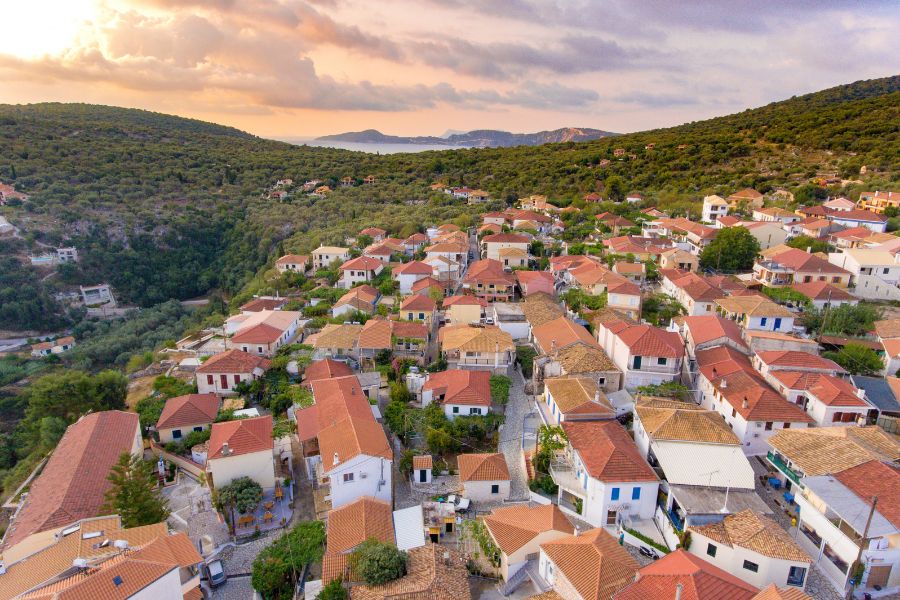
It’s become my secret escape when I need to remember what the Greek islands felt like before Instagram changed everything.
Fjord-Like Bays and Sea Caves of Meganisi
Meganisi’s northern coastline surprised me with narrow fjord-style inlets that could almost pass for Norway. The island’s biggest sea cave stretches an unbelievable 120 meters deep.
Crystal-clear water fills every bay, making them perfect for swimming and exploring. I couldn’t resist diving in.
The Most Beautiful Fjord-Style Inlets
The north side of Meganisi shattered my expectations with its dramatic fjord-like bays. These narrow inlets cut deep into the coast, creating calm, sheltered waterways that feel nothing like the usual Greek beaches.
Spilia Bay immediately stands out. I found this inlet stretching nearly 300 meters inland, flanked by steep rocky walls.
The water here stays calm and inviting, perfect for anchoring and swimming. I could’ve stayed all afternoon.
Near Vathy village, another fjord-like inlet opens into a wide bay ringed by green hills. I swam across it in minutes, just to say I did.
These bays stay protected from the Ionian winds. Most reach depths of 8-15 meters, which is perfect if you’re sailing or just want to jump in.
The water runs a couple degrees warmer than the open sea, which I definitely noticed.
Famous Sea Caves to Explore
Papanikolis Cave really steals the show. This massive cave tunnels 120 meters into the rock along Meganisi’s southwest coast.
When I measured the entrance, it stretched a whopping 60 meters wide and 20 meters high above the water.
As you swim deeper, the cave narrows from 60 meters to 23 meters. The water’s so clear you can see the sandy bottom, and stalactites dangle from the ceiling.
At the far end, there’s a little hidden beach. The sand feels soft and untouched, tucked away from the world.
Legend says the WWII submarine Papanikolis hid here, which adds a bit of mystery.
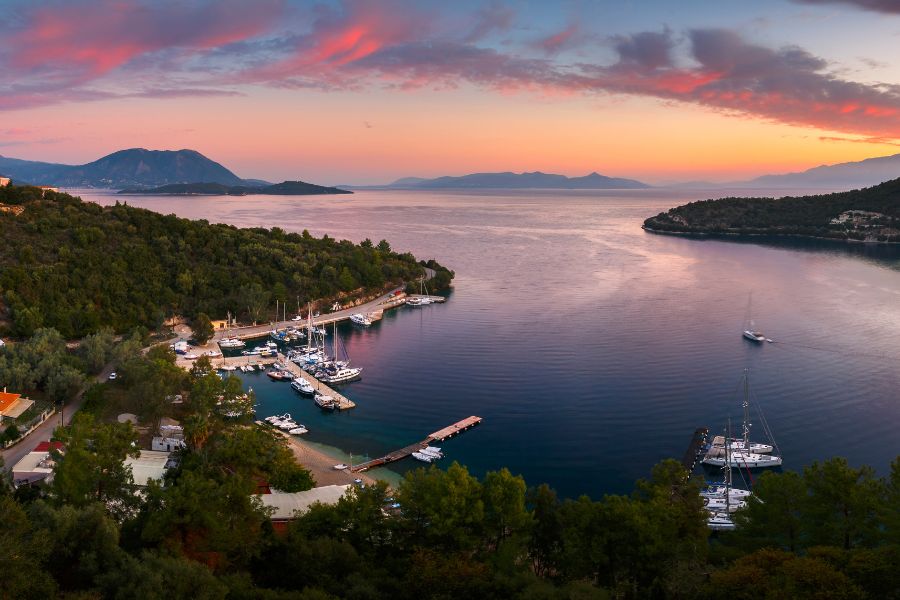
Smaller caves cluster near Spartochori. Most stay shallow, about 10-30 meters deep. I could swim right into several without needing a boat.
Sunlight filters through underwater cracks, lighting up the water in electric blue.
Best Spots for Swimming and Snorkeling
Papanikolis Cave gives you the most unique swim on the island. I floated through the whole 120-meter tunnel, the water warm and calm.
That secret sandy beach inside? Worth the effort for a quiet rest before heading back out.
The fjord-style bays are a snorkeler’s dream. Spilia Bay stays clear all year, and I spotted fish darting between rocks at just a few meters deep.
Water temperatures start around 22°C in May and climb to 26°C by August. The Ionian Sea stays warmer than the Aegean, so you can swim well into October.
Near Vathy, underwater rocks form natural swimming pools. Depths shift from 2 to 12 meters, so there’s something for everyone.
I anchored my boat in the soft sand and just dove in. Couldn’t have asked for better.
Authentic Villages and Local Life
Meganisi’s three main villages each show off a different side of Greek island life. From the hilltop capital to quiet mountain retreats, time seems to slow down here.
Katomeri: Heart of the Island
Katomeri acts as Meganisi’s capital and main hub. I found this hilltop village gives you the best views across the Gulf of Atherinos.
The village sits high above the sea, so you get sweeping panoramas everywhere you look. Most of the island’s shops and tavernas gather here.
Life centers around the main square. Locals come out in the evenings, and the pace drops to a crawl after sunset.
Key Features:
- Administrative center of the island
- Best panoramic views
- Main cluster of restaurants and cafes
- Traditional white-washed buildings
Katomeri keeps its authentic Greek feel, even with visitors around. Families have lived here for generations, sticking to old traditions.
Kefali: Mountainous Retreat
Kefali is Meganisi’s quietest spot, hidden in the island’s hilly interior. This tiny village feels a world away from the coast.
I wandered narrow stone paths between houses built right into the hillside. The architecture looks like it hasn’t changed in centuries.
Tourists rarely make it to Kefali. That means you get a real taste of undisturbed island culture.
Locals tend their gardens and olive trees, keeping old ways alive. Elderly residents mostly speak Greek and stick to time-honored customs.
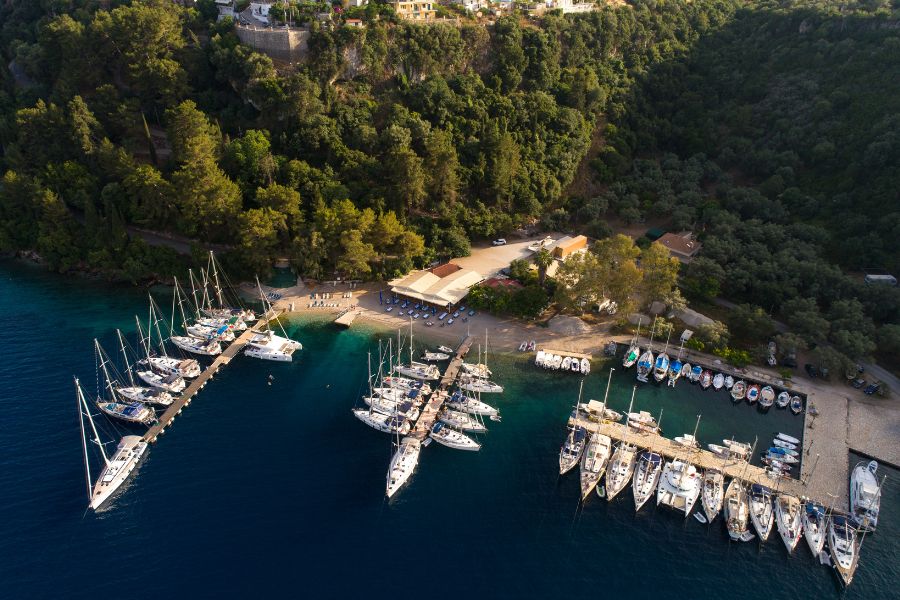
Stone houses blend right into the landscape. The peace and quiet here are something special.
Agios Ioannis: Spiritual Heritage
Agios Ioannis centers on its historic church, which gives the village its name. This small community keeps Meganisi’s religious traditions alive.
The church acts as both spiritual center and gathering place. Local festivals and celebrations revolve around religious events.
Traditional houses cluster around the church, creating a tight-knit feel. Residents keep strong ties to Greek Orthodox customs.
Church bells ring out to mark important moments each day. Families here have looked after the church for generations.
This area gives you a window into the island’s spiritual side and close community bonds.
Unspoiled Natural Environment
Meganisi’s natural beauty hit me right away. Dense Mediterranean forests cover the island, and protected status keeps development at bay.
The island’s spot in the Natura 2000 network helps unique ecosystems thrive in this Ionian hideaway.
Lush Trees and Verdant Landscapes
Olive groves and pine forests create a thick green canopy over most of Meganisi’s 20 square kilometers. The greenery really stands out compared to other Greek islands.
Mediterranean pine trees dominate the higher ground. These tough trees offer shade along hiking paths and sometimes reach right down to the sea.
Ancient olive trees blanket the terraced hills. Some look hundreds of years old, their trunks thick and twisted from generations of care.
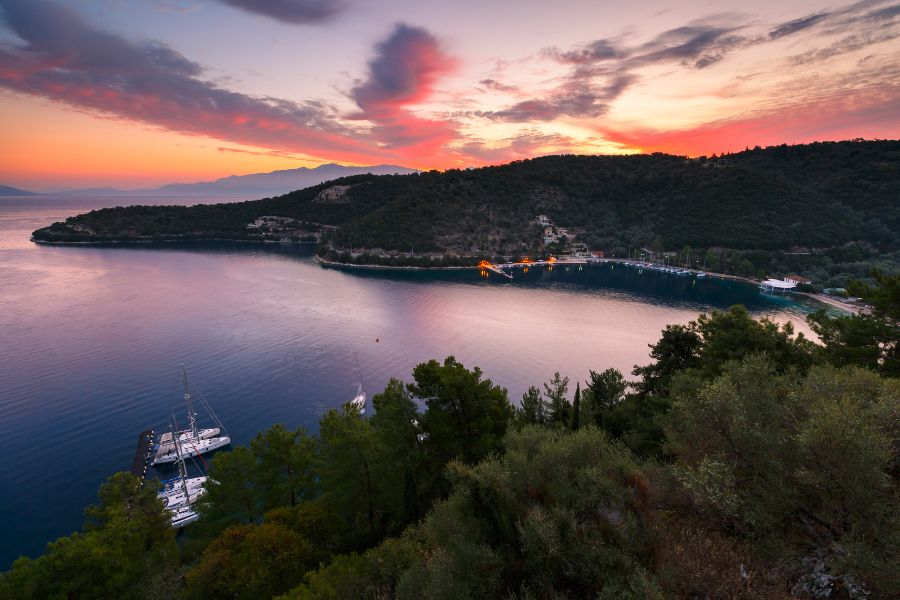
Cypress trees line the ridges, their dark green shapes sharp against the blue sky. Wild herbs like oregano, thyme, and rosemary grow everywhere, especially along the coast.
Unique Flora and Fauna
Meganisi supports plant species that only thrive in these Ionian conditions. The island’s isolation has created some cool ecological niches.
Wildflowers burst into bloom every spring. I spotted native orchids, poppies, and sea lavender on my March and April visits.
Birdwatchers will love it here—peregrine falcons nest in the cliffs, and seabirds flock to the fjord-like inlets.
The waters around Meganisi stay incredibly clear, often with 20-meter visibility. Seagrass beds and rocky reefs shelter all kinds of fish.
Reptiles like the Balkan green lizard and geckos scurry over the rocks. They help keep the insect population in check.
Protected Areas and Conservation
Meganisi sits inside the Natura 2000 network, which protects its habitats. That means development faces tough restrictions.
The whole coastline gets special protection for its geology. Over 30 kilometers of twisting shoreline, sea caves, and inlets need careful management.
Building restrictions keep construction limited to certain zones. Most of the interior and the sensitive coast remain untouched.
Local groups work hard on marine protection. Fishing rules help local species thrive.
Some beaches have extra protection as environmentally sensitive areas. That helps nesting sites and fragile dunes stay safe.
Seaside Dining and Tavern Culture
Meganisi’s food scene revolves around waterfront tavernas serving up fresh seafood and classic Greek dishes. Each village brings its own flavor, from family-run gems to stylish marina restaurants.
Stavros Family Tavern at Atherino
I found Stavros Family Tavern tucked away in sleepy Atherino. This spot sums up everything I adore about authentic Greek dining.
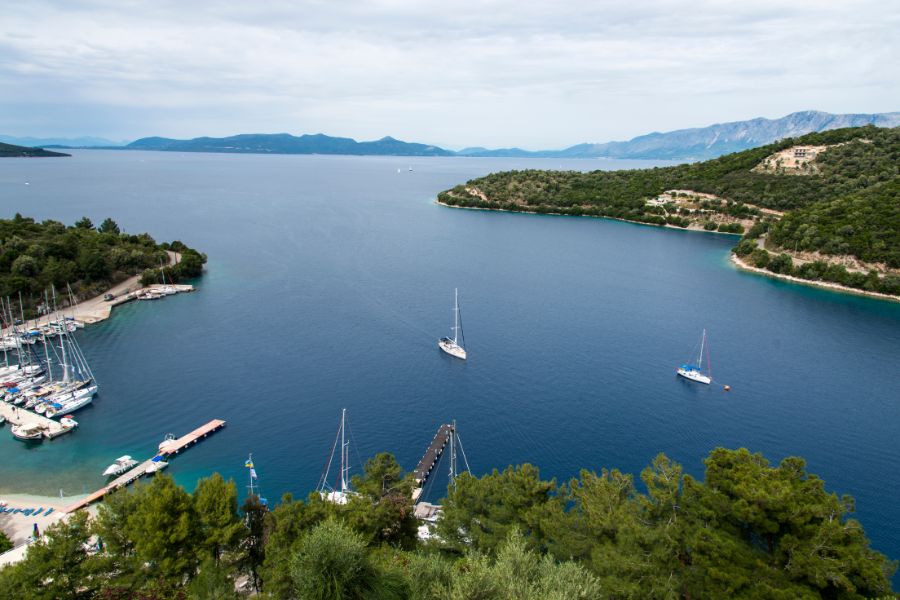
The same family has run it for decades. They stick to simple, honest recipes handed down over generations.
Why it’s special:
- Fresh fish caught daily by local fishermen
- Tables just steps from the water
- Laid-back vibe and real hospitality
The grilled octopus blew me away. I watched them tenderize it on the rocks before tossing it on the grill.
Their moussaka features veggies straight from the family garden. Portions are generous, and prices are a relief compared to the bigger islands.
Village Tavernas and Local Cuisine
Each village has its own taverna scene. Vathy offers the most choices, while Spartochori and Katomeri feel more intimate.
In Vathy, I tried Marinata and Tilevoes right by the harbor. Both serve Mediterranean dishes with killer sea views.
The outdoor tables let you watch fishing boats come in with the day’s catch. It’s a simple pleasure.
Spartochori is home to Tsovolas, a grill house tucked into a stone building. I sat in their garden, sampling homemade tzatziki and other Greek staples.
Katomeri has Toboles, a cozy spot with friendly faces. It almost feels like dining at someone’s house.
Most places use ingredients from the island itself. Local olive oil and garden veggies show up in nearly every dish.
Fresh Seafood Specialties
The seafood here honestly beats what I’ve tasted on bigger islands. Fishermen bring in the catch every morning, so it doesn’t get fresher.
You’ll often find:
- Red mullet (barbounia)
- Sea bream (tsipoura)
- Octopus (htapodi)
- Fresh sardines
I always order the whole grilled fish. Tavernas keep it simple—just lemon, olive oil, and herbs—so the flavors shine through.
Gimlet Wine Bar in Vathy adds a modern spin, serving sushi-inspired plates alongside traditional dishes. Their wine list is worth checking out too.
If you want to splurge, try the lobster pasta. Several tavernas make it with local lobster, and yes, it’s worth every euro.
Sailing, Island Hopping, and Neighboring Destinations
Meganisi sits in a sweet spot for sailing adventures and island hopping across the Ionian Sea. The sheltered bays make anchoring easy, and islands like Lefkada, Kastos, and Kefalonia are all close enough for a quick hop.
Anchoring and Sailing Tips
When I sailed here, Meganisi’s fjord-like bays felt like some of the best natural harbors in the Ionian. Vathi Bay stands out—it’s super protected, and the holding ground is great in about 3 to 8 meters of water.
Along the northern coastline, you’ll spot smaller coves that are perfect for lunch stops. I usually anchor in sandy patches between rocks for a bit more grip.
Weather to watch for:
- Northwest winds sometimes rush through the channel between Meganisi and Lefkada.
- In the afternoon, sea breezes pick up from the southwest.
- If you leave early in the morning, you’ll usually get the calmest water.
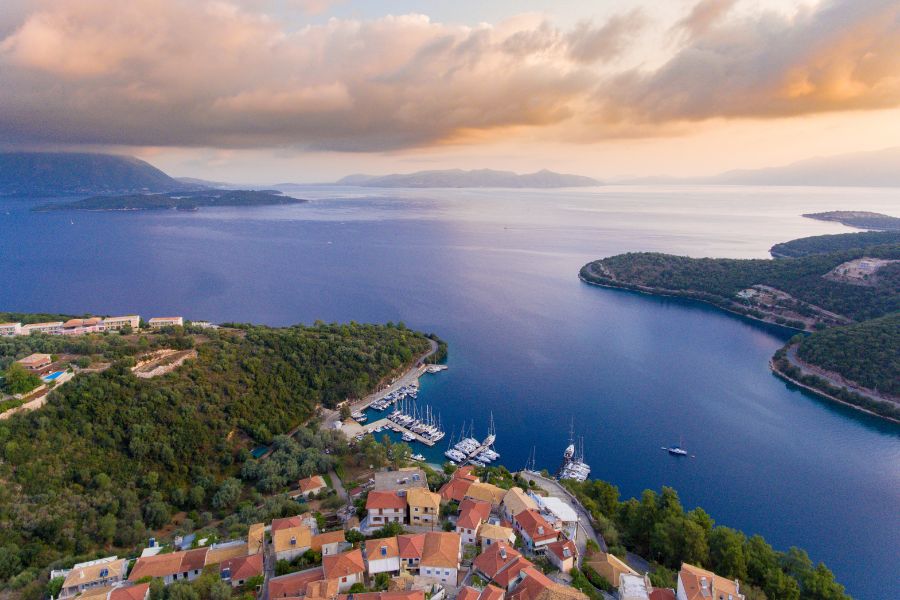
Meganisi’s sheltered position means you can still get in and out even when the rest of the Ionian feels rough. Most charter boats can easily handle the short distances to the neighboring islands.
Excursions to Lefkada and Kastos
Lefkada is just 4 nautical miles northwest. With moderate winds, I made it there in under an hour. The island buzzes with activity—harbors, restaurants, and spots to restock.
Lefkada highlights:
- Nydri harbor for fuel and supplies.
- Vassiliki for windsurfing or a bit of nightlife.
- Porto Katsiki beach, though you’ll need a car from the marina.
Kastos is about 8 nautical miles southeast, so a little over an hour’s sail. It’s tiny—fewer than 100 people live there.
There’s just one village, and it wraps around a small, clear-water harbor. I grabbed fresh fish and local wine at a taverna right by the water. Honestly, if you want peace and quiet, Kastos is a dream for a day trip.
Exploring Kalamos, Kefalonia, and Ithaca
Kalamos sits 12 nautical miles south. I found dramatic cliffs and hidden beaches along its west coast. The main port’s got basic supplies and that classic Greek vibe.
Kefalonia is a longer haul—about 25 nautical miles southeast. The island’s pretty big and offers:
- Fiskardo’s Venetian-style buildings.
- Assos village, complete with fortress ruins.
- The famous white cliffs at Myrtos Beach.
Ithaca is 18 nautical miles southeast. It’s legendary—literally, thanks to Homer. There are hiking trails and archaeological sites to explore. Vathy, the main town, has good shelter and places to stock up.
With these islands so close, you can easily plan a week-long sailing loop through some of the Mediterranean’s most beautiful waters.
Frequently Asked Questions
Getting to this hidden Ionian spot takes a ferry from Lefkada. Meganisi’s three small villages don’t have loads of restaurants, but the food is authentically Greek.
What are the best ways to travel to Meganisi from mainland Greece?
To reach Meganisi, you’ll need to get to Lefkada first. Luckily, Lefkada connects to mainland Greece by a bridge.
From Lefkada, ferries run to Meganisi from Nidri port. The ride only takes about 30 minutes, with several daily departures in summer.
Check ferry schedules ahead of time. They can change, especially in winter or when the weather acts up.
Are there any particular beaches in Meganisi that are considered must-visit?
Meganisi’s fjord-like bays really stand out in Greece. I’ve found the northern coastline gives you the most dramatic scenery.
Down south, you’ll find sea caves and quiet coves—perfect for swimming in clear water.
Most beaches are only reachable by boat. I usually rent a small boat or join a tour to see the best spots.
What are some of the top activities to do when visiting Meganisi?
Honestly, relaxing is the main event here. The island feels peaceful, and the natural beauty does most of the work.
Boat trips are a must if you want to see the sea caves and hidden coves. You can drift from one beach to another at your own pace.
Swimming and snorkeling are great, too. The water’s clear, and the marine life is easy to spot.
Can visitors rent a car on Meganisi, and is it recommended for exploring the island?
Meganisi’s small, so you don’t really need a car. I usually walk between the three villages, and it’s pretty manageable.
The roads connect Vathi, Katomeri, and Spartochori. Most places you’ll want to see are within walking distance or a short boat ride away.
Honestly, boats are the way to go for the best beaches and sea caves. You’ll reach places that cars just can’t get to.
What is the population of Meganisi and how does it impact the tourist experience?
Meganisi has a tiny permanent population, mostly in the northern villages.
Because there aren’t many people, the island never feels crowded. You get a peaceful, authentic experience.
Sometimes, I feel like I have the place to myself. If you’re after tranquility and unspoiled nature, Meganisi’s got you covered.
Where are the best places to dine in Meganisi for authentic local cuisine?
Each of the three villages has its own handful of dining spots. I’ve noticed the tavernas here really lean into traditional Greek recipes, usually with ingredients that feel like they came straight from someone’s backyard.
Vathi, the main port, draws you in with its waterfront restaurants. When I sat down here, I found the seafood especially fresh, and the menus often celebrate all those classic Greek flavors.
Spartochori and Katomeri, on the other hand, keep things cozy with their smaller, family-run tavernas. If you’re after something that feels homemade and personal, these places absolutely deliver.

